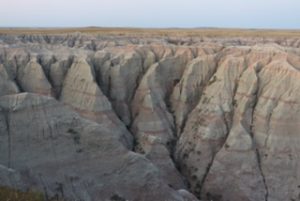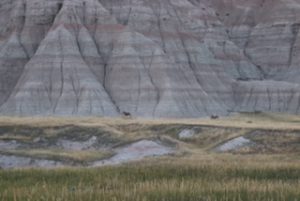
Turns out, the Badlands aren’t so bad after all. Given their name “mako sica” (bad lands) by the Lakota tribes that lived throughout South Dakota and this region of the country, the terrain is rocky and steep, highly erodible,and sparsely vegetated. You definitely couldn’t farm it, but it was ideal for herding buffalo off the edge of cliffs for an epic hunt. They are, however, stunningly beautiful. On my family’s vacation this week, we drove the scenic loop through the national park in the two hours before sunset. The layers of sedimentary rock turned to deep shades of pink, orange, and purple as the sun dropped, adding to the surreal moonscape views.

Badlands National Park encompasses 244,000 acres of land, and is managed jointly by the National Park Service and the Ogala Sioux tribe. Throughout the mixed grass prairies are fossil-laden buttes, spires, and pinnacles. These interesting geologic formations are composed of sandstone from ancient rivers, limestone from calcium in groundwater, and volcanic ash from eruptions as far away as Nevada and Utah. The sandcastle-like peaks built up in layers over millions of years, with rock and ash pushed in by wind, rivers, and shallow inland seas. The base of the geologic formation is called the Pierre Shale, which formed over a timeframe between 75 and 28 million years ago. Approximately 500,000 years ago, the Cheyenne and White Rivers began eroding the rocks away, winding through the landscape to form canyons and deep cuts. The Badlands still erode today at a rate of one inch per year.

Big-horned sheep roamed the park, prairie dogs peeked out from thousands of holes dotting the landscape, and a golden eagle perched atop a rock, waiting for potential prey. A large herd of bison populates the park. Located in a remote region of a sparsely populated state, Badlands National Park is one of several “Dark Sky” parks with almost no ambient light pollution. During an astronomer/ranger-led evening program, the Milky Way was clearly visible, as were thousands of stars and multiple satellites.
While the capital-B Badlands are in western South Dakota, these geologic formations are found all over the world and throughout the American West. Theodore Roosevelt National Park in North Dakota and sections of Arizona, Wyoming, Utah, Colorado, and Nebraska have badlands, along with regions as diverse as Italy, New Zealand, and Argentina.
 1
1
